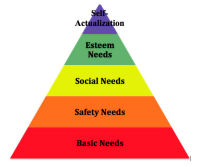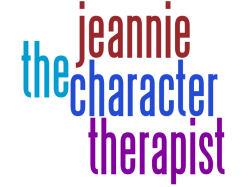|
 After
recently brushing up on human motivation theory (no need to bore you
with details, but you can do a Google search to learn more), I realized
that a simple little pyramid developed by psychologist Abraham Maslow
might help us figure out what our characters want. After
recently brushing up on human motivation theory (no need to bore you
with details, but you can do a Google search to learn more), I realized
that a simple little pyramid developed by psychologist Abraham Maslow
might help us figure out what our characters want.
In essence, Maslow’s theory is
that there is a hierarchy, or pecking order, of human needs. This
theory can be applied to your character’s lives, but misapplication
might fail to suspend a reader’s disbelief.
We’ll start from the bottom of
the pyramid this month and work our way up through the lower Basic,
Safety, and Social needs. Next month we’ll look at the higher needs.
Basic Needs
are the primary things a person needs to survive: air, water, and food.
Other base needs include maintaining body temperature for survival,
sleeping, keeping shelter, and staying clothed.
Cold, Hard Truth:
If your heroine is starving, freezing, or being deprived sleep, she
won’t be wondering if she is in love with the hero or if her 401(k) is
growing fast enough. When people are deprived of the basics of life,
those needs become a priority. It’s not realistic to have them musing,
reflecting, or speculating about so-called “higher” needs.
Safety Needs
encompass the need for security, stability, and protection. When basic
needs are met, a person is free to think about “higher” order concerns,
fears, or anxieties. People generally want some structure, order, and
limits in their world. They want predictability and familiarity.
At this level, most adults focus
on the four types of safety/security:
1) Person and Property:
This is when people put alarm systems on their houses or cars or
implement a neighborhood watch system. They might feel the need to
carry a firearm, install motion detection lights outside their homes,
and password-protect their laptops. People also appreciate grievance
procedures developed on many different levels (government, work,
church) to protect against maltreatment.
2) Financial Security:
Adults generally seek jobs that will give them the most security while
making the most money possible. People will save money by way of
savings accounts, investments, IRAs, or piggy banks masquerading as a
book in the library.
3) Health and
Well-being. We each get only one body, and while we can alter
it considerably with surgeries and the like, we had better have good
insurance to do so. In order to protect against the financial crises
brought on by serious illnesses, broken bones, or other health-related
issues, people must have insurance or some other social program to fall
back on.
|
4)
The future. All of the above greatly affect a person’s
future. People enjoy planning for the time when they won’t have to work
and can enjoy doing what they want to do, but things have to be put in
place while they are still working, like having a good retirement plan.
It’s important to have a safety net (or as Dave Ramsey likes to say, an
“emergency fund”) for when there might be a major accident or illness.
Cold Hard Truth:
The importance of these two levels cannot be overstated: a person can’t
fully give of
themselves to others (in true friendship, romantic love, and intimacy)
before these needs are met. It wouldn’t make sense for a character to
pine for love when his or her basic need or safety need is not met.
If you think back to what you’ve
written in previous books or manuscripts, you’ll likely see that you’ve
already done this. You probably have heroines/heroes who already have
stable jobs and ready access to food (I’m sure most have never put
thought to this!) before they look to get romantically involved.
So once characters have taken
care of themselves physically, they are ready to share themselves with
others in a meaningful way, which leads to Social Needs,
which encompass the need for love and belonging, both small and large.
In fact, many versions of Maslow’s Hierarchy of Needs call this level
the Psychological or Love Needs.
People want to be surrounded by
friends, a sweetheart, a spouse, children, neighbors, office coworkers,
church, and community. This is a need to have relationships, either
through marriage, family, fraternity, gang, or club. This truly is a
psychological need, one we feel with both our heads and our hearts.
It’s intimacy, the need to love and be loved, in both a sexual and
nonsexual way.
Of course, there are exceptions
in fiction to every rule, even more so for a theory like Maslow’s. Twilight’s
Bella Swan forsook her safety for love of a vampire. Anorexics
regularly ignore the need to eat and the security of health to have a
feeling of belonging and acceptance and control. Individuals with
borderline personality disorder are so driven by emotional needs that
they act in hysterical and disturbing ways, definitely capable of
jeopardizing their own safety.
Next month we’ll look at
Maslow’s upper level needs, so see you then!


|